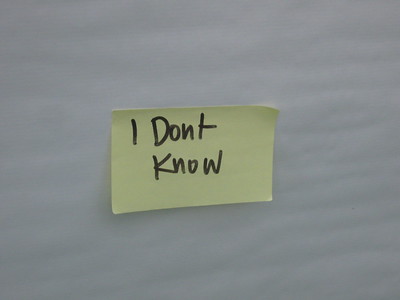Nobody will look for knowledge from others if they think they already know what to do, and you cannot teach anyone anything if they think they know it already. Therefore the most effective way to promote a desire to learn in an organisation, is to move people out of their comfort zone.
 |
| An honest post-it, by Hilary Perkins, on Flickr |
This means that the best way to promote learning and re-application of knowledge across an organisation is to give people challenges they don't know how to meet. To push them out of the comfort zone of “I know how to do this”, into a zone of “this is tough – I’d better see what knowledge is out there that can help me”. Then they will look for knowledge from others, to help them solve the problem.
It's a question of receptivity. You can't transfer knowledge unless the recipient is receptive. To be receptive, they have to feel a need to learn something. If they feel they don't need to know, they won't be receptive to external knowledge. Epictetus knew this in 2nd century Rome when he said "It is impossible for a man to learn what he thinks he already knows." See also the story of the nurses.
Examples from industry
John Browne (the BP CEO in the 90s and early 00s) recognised this issue, and offered a challenge.
He said that he expected every project to deliver better than the previous project (often radically better), and his budget allocations and performance targets reflected this. He forced continuous improvement in delivery and cost, and the only way to continuously improve was to continuously learn. For the project manager, these "stretch goals" were often seriously uncomfortable ("How on earth does he expect me to cut the budget by another 20%?”) and it pushed them to seek advice, look for the best of the best, and build upon the entire knowledge base of the organisation. As a result, these stretch targets were drivers of innovation, knowledge management and continuous improvement.
Ford did this as well, in the days of the Ford Best practice Replication System. Through applying continuously decreasing operating budgets, they forced their plants into a situation where they were outside their comfort zone, and had to learn in order to deliver to the new budgets.
In both cases, the strong delivery push from management was supported by an organisational framework that made knowledge management possible.
Just increasing the pressure without providing the framework would not have worked – it would have added stress to the organisation. Increasing the pressure while also providing the ability to learn, on the other hand, provided the incentives for knowledge to flow around the system to where it was needed (driven by “demand Pull”), and fuelled continuous performance increase over a number of years.
So remember, if you want to promote a knowledge seeking culture in your company (and a knowledge seeking culture is a far better driver of KM than a knowledge sharing culture), then you and your senior managers need to push people out of the comfort zone, so that they can no longer rely on what they already know.




No comments:
Post a Comment